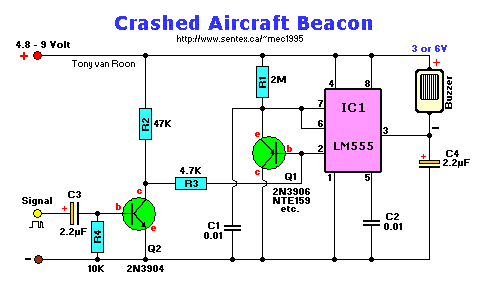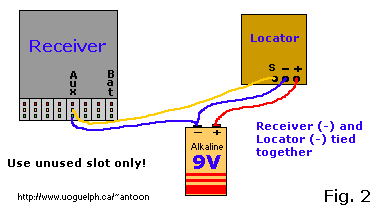
Parts List:
R1 = 2M C1,C2 = 0.01uF (10nF), Ceramic
R2 = 47K C3,C4 = 2.2uF, Tantalum (or electrolytic)*
R3 = 4.7K tantalum was chosen for its weight.
R4 = 10K Q1 = NTE159, PN200, *BC557(a), 2N3906, etc.
U1 = LM555 Q2 = NTE123AP, PN100, *BC547(a), 2N3904, etc.
U1, the timer/oscillator IC, LM555, NE555, SE555(c), NTE955, ECG955, etc.
The CMOS version of this IC, (MC1455P) uses only 1/10th the current!).
3 volt buzzer, servo connector to fit your receiver pack (optional).
The above circuit is available as a parts *only* KIT. No PCB! [Click Here]
Final Notes:
Most every R/C'er knows how hard it is to find a crashed or downed plane in high grass, thick brush, corn or soy
fields. Many aircraft are probably still laying there waiting to be found. This circuit will help you to find
your aircraft/rocket easily. It is easy to build and does not require special parts. Using replacements is just
fine. If you opt for a seperate 9-volt battery (don't forget an on/off switch) the buzzer should be approx. 6-volt.
Do *NOT* connect the + of the 9-volt battery to your receiver! Serious damage will occur! In my prototype I put
silicon gel arround all the electronic components, immediately put the hole thing in heat-shrink and left to dry
overnight. It now is vibration-proof. The circuit was still working when my Goldberg Falcon Mark III folded the
wings from a height of about 400 feet and slammed into the ground (at full trottle) and dug itself in almost 6
inches deep.

Just in case you're wondering how to hookup the 9-volt alkaline battery:
Fig. 2 The negative (-) of the 9-volt battery and the rx-battery pack are tied together.
Keep in mind, if you hookup the battery incorrectly you may damage your receiver, so be careful. Can you use the receiver's
battery power? Yes ofcourse. It will just drain your receiver battery a lot faster. If you are into slope soaring,
gliders, or any other area of R/C with long-duration of your radio/receiver batteries, I strongly recommend to use a
seperate 9 volt battery. To save on weight, NiMH would be my choice. It is true 9-volt versus NiCad being 7.2 volt.
A transmitter provides every 20 milliseconds a set of pulses, which in turn sends your receiver a seperate pulse
to each of the servos at the same interval. The circuit above is a so-called
missing-pulse-detector. An alarm will sound when your receiver no
longer receives the set of pulses from your radio. So, to locate your aircraft, all you have to do is switch
your transmitter off and the locator will start to beep. Easy huh? If you wish, you may even use point-to-wiring
on vero board or something. The tantalum capacitors are polarized so watch the + and - sides. This circuit works
best when just plugged into an empty position of the Receiver. I do not use the 9-volt battery setup myself, since I
only fly 15 minutes with my heli at a time.
If you need more information and data on the 555 timer/oscillator IC, click NE555
here.
*CAUTION: The European BCxxx type transistors have their emitter/collector
reversed in most cases. Check for proper pinout first to make sure it is so.
This device is tested for interference with most models modern radio equipment. None were found and none are expected
when used with other brands of Radio equipment.
Back to Gadgets Menu page
Copyright © Tony van Roon


